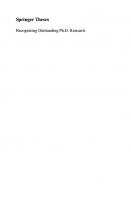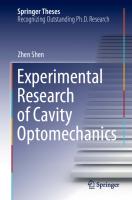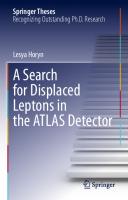A New Generation of Ultrafast Oscillators for Mid-Infrared Applications (Springer Theses) 9783030897536, 9783030897543, 3030897532
This thesis presents the first successful realization of a compact, low-noise, and few-cycle light source in the mid-inf
118 98 4MB
English Pages 157 [155]
Table of contents :
Supervisor’s Foreword
Abstract
Acknowledgements
Contents
List of Acronyms
1 Motivation
1.1 MIRanda–-A New Ultrafast Workhorse for Mid-Infrared Applications
1.2 The Power of Directly Diode-Pumped, Few-Cycle Mid-Infrared Lasers
1.3 Thesis Outline
References
2 Fundamentals of Ultrashort Pulse Generation
2.1 Formation of Laser Pulses
2.1.1 Locking the Longitudinal Modes of a Laser Cavity
2.1.2 Experimental Realization Methods
2.2 Soliton Pulse Propagation
2.2.1 Dispersion
2.2.2 Self-Phase Modulation
2.2.3 The Fundamental Soliton
2.3 Soliton Mode-Locking
2.3.1 Gain, Loss, and the Spectral Filtering
2.3.2 Self-Amplitude Modulation
2.3.3 The Master Equation of Mode-Locking
2.3.4 The Effect of Different Dispersion Regimes
2.4 Summary
References
3 The First Directly Diode-Pumped Few-Cycle Cr-Doped II-VI Laser
3.1 Chromium-Doped II-VI–-The Titanium Sapphire of the Mid-Infrared
3.2 Challenges of Diode-Pumping
3.2.1 The Right Choice of Laser Diode Type
3.2.2 Properties of Single-Emitter Diodes
3.2.3 Effects on the Laser System and the Few-Cycle Pulse Generation
3.3 Few-Cycle Pulse Generation via Kerr-Lens Mode-Locking
3.3.1 Pump Setup and Resonator Design
3.3.2 The Importance of Intra-cavity Dispersion Management
3.3.3 Characterization of the Mode-Locked Output
3.3.4 The Success of Powerful Diode-Pumped Operation
3.4 Summary
References
4 Reaching the Performance of State-of-the-Art Fiber-Pumped Systems
4.1 Challenges of Reaching Higher Average and Peak Powers
4.1.1 Pump Setup Considerations
4.1.2 Effects on the Mode-Locking Performance
4.2 Comparison and Improvements over MIRanda1
4.2.1 Pump and Cavity Design
4.2.2 Mode-Locked Performance
4.3 Summary
References
5 Pushing the Peak Power for Direct Mid-Infrared Generation
5.1 Challenges of Reaching Higher Peak Powers
5.2 Experimental Achievements
5.2.1 Pump and Oscillator Setup
5.2.2 Mode-Locked Performance and the Effect of Air Dispersion
5.2.3 Towards Even Higher Peak Power Levels
5.3 Frequency Down-Conversion into the Mid-Infrared
5.3.1 Intra-Pulse Difference Frequency Generation in a ZGP Crystal
5.3.2 Characterization of the Generated Radiation
5.4 Summary
References
6 Conclusion and Outlook
6.1 Summary
6.2 A New Ultrafast Workhorse for Spectroscopic Applications?
6.3 Closing Remarks
References
Appendix
A.1 Data Archiving
A.2 Curriculum Vitae
A.3 List of Publications
Supervisor’s Foreword
Abstract
Acknowledgements
Contents
List of Acronyms
1 Motivation
1.1 MIRanda–-A New Ultrafast Workhorse for Mid-Infrared Applications
1.2 The Power of Directly Diode-Pumped, Few-Cycle Mid-Infrared Lasers
1.3 Thesis Outline
References
2 Fundamentals of Ultrashort Pulse Generation
2.1 Formation of Laser Pulses
2.1.1 Locking the Longitudinal Modes of a Laser Cavity
2.1.2 Experimental Realization Methods
2.2 Soliton Pulse Propagation
2.2.1 Dispersion
2.2.2 Self-Phase Modulation
2.2.3 The Fundamental Soliton
2.3 Soliton Mode-Locking
2.3.1 Gain, Loss, and the Spectral Filtering
2.3.2 Self-Amplitude Modulation
2.3.3 The Master Equation of Mode-Locking
2.3.4 The Effect of Different Dispersion Regimes
2.4 Summary
References
3 The First Directly Diode-Pumped Few-Cycle Cr-Doped II-VI Laser
3.1 Chromium-Doped II-VI–-The Titanium Sapphire of the Mid-Infrared
3.2 Challenges of Diode-Pumping
3.2.1 The Right Choice of Laser Diode Type
3.2.2 Properties of Single-Emitter Diodes
3.2.3 Effects on the Laser System and the Few-Cycle Pulse Generation
3.3 Few-Cycle Pulse Generation via Kerr-Lens Mode-Locking
3.3.1 Pump Setup and Resonator Design
3.3.2 The Importance of Intra-cavity Dispersion Management
3.3.3 Characterization of the Mode-Locked Output
3.3.4 The Success of Powerful Diode-Pumped Operation
3.4 Summary
References
4 Reaching the Performance of State-of-the-Art Fiber-Pumped Systems
4.1 Challenges of Reaching Higher Average and Peak Powers
4.1.1 Pump Setup Considerations
4.1.2 Effects on the Mode-Locking Performance
4.2 Comparison and Improvements over MIRanda1
4.2.1 Pump and Cavity Design
4.2.2 Mode-Locked Performance
4.3 Summary
References
5 Pushing the Peak Power for Direct Mid-Infrared Generation
5.1 Challenges of Reaching Higher Peak Powers
5.2 Experimental Achievements
5.2.1 Pump and Oscillator Setup
5.2.2 Mode-Locked Performance and the Effect of Air Dispersion
5.2.3 Towards Even Higher Peak Power Levels
5.3 Frequency Down-Conversion into the Mid-Infrared
5.3.1 Intra-Pulse Difference Frequency Generation in a ZGP Crystal
5.3.2 Characterization of the Generated Radiation
5.4 Summary
References
6 Conclusion and Outlook
6.1 Summary
6.2 A New Ultrafast Workhorse for Spectroscopic Applications?
6.3 Closing Remarks
References
Appendix
A.1 Data Archiving
A.2 Curriculum Vitae
A.3 List of Publications

- Author / Uploaded
- Nathalie Nagl








